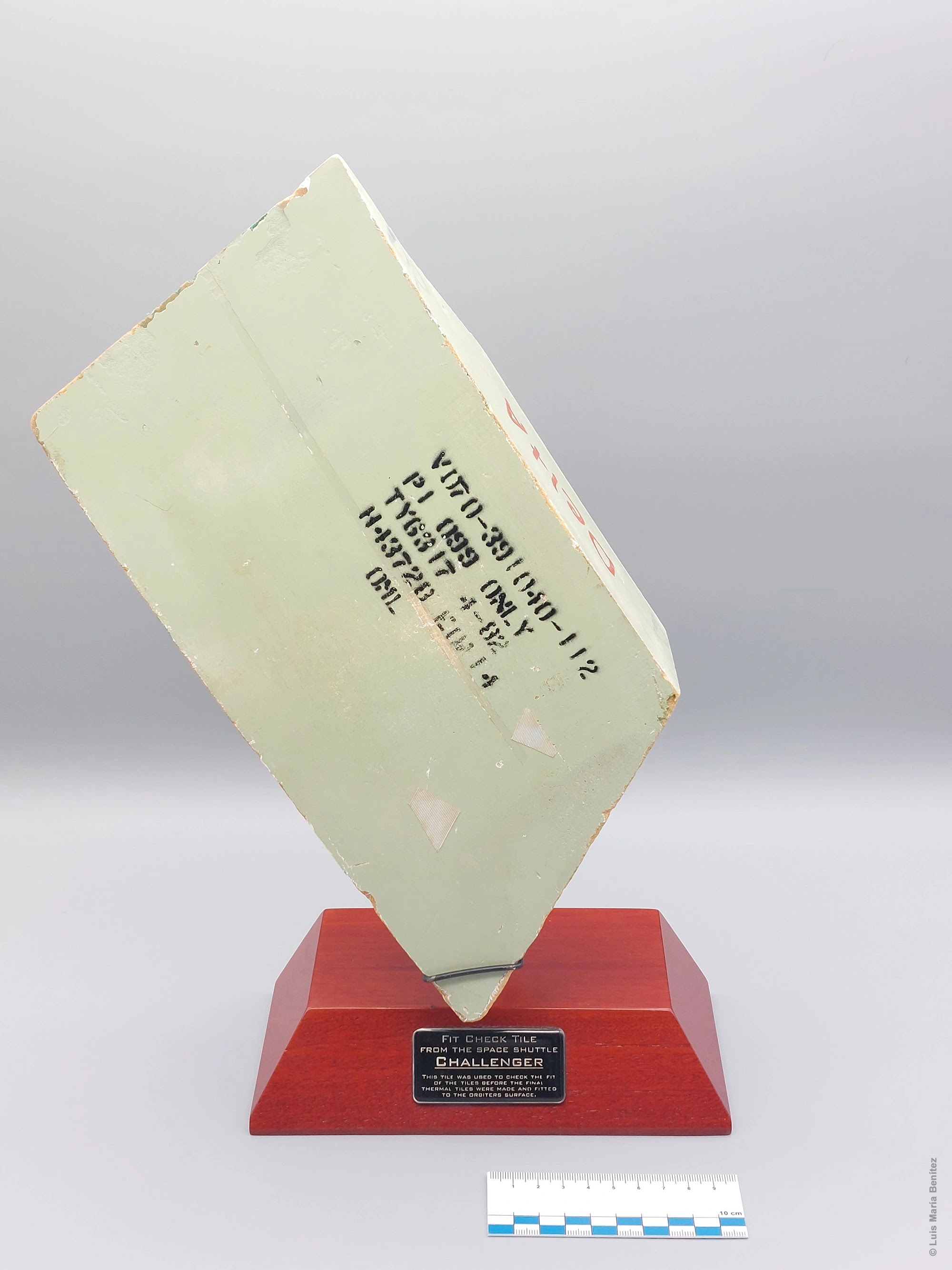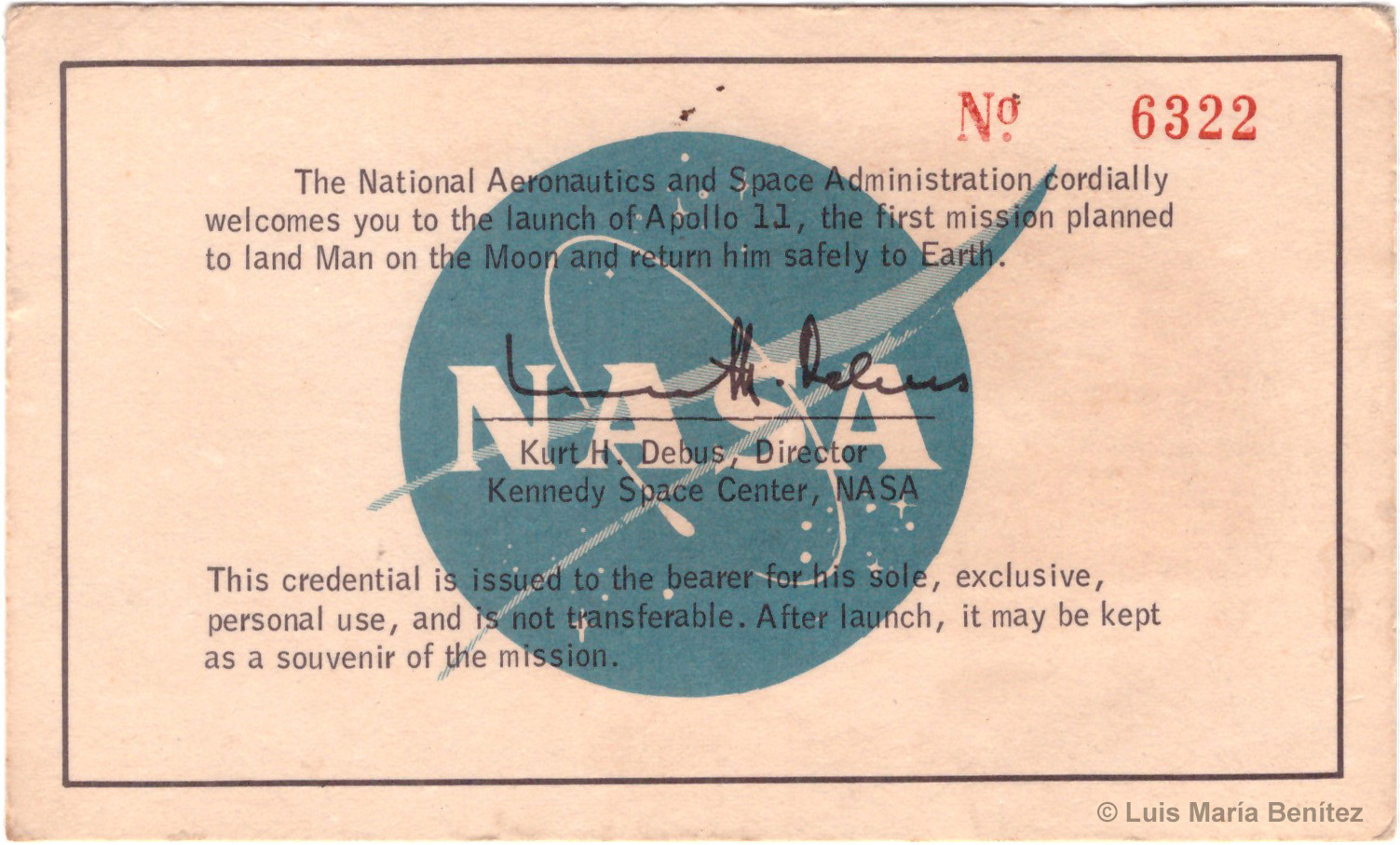Artifact: "The Last Man on the Moon: Astronaut Eugene Cernan and America's Race in Space", signed by Gene Cernan Author: Eu...
“The Last Man on the Moon: Astronaut Eugene Cernan and America's Race in Space”, signed by Gene Cernan
Author: Eugene Cernan and Don Davis.
Publisher: St. Martin's Press.
Date: July, 2000.
Dimensions: 24.2 x 16.2 x 3 cm.
Weight: 622 gr.
Pages: 356.
Description:
Written with New York Times bestselling author Don Davis, The Last Man on the Moon was the basis of the 2014 award-winning feature-length documentary. A revealing and dramatic look at the inside of the American Space Program from one of its pioneers.
Item: Space Shuttle HSRI tile Size: 15.2x15.2x9x10.9x8.8x7.4 cms. Weight: 338 gr. Serial number: VO-070-193004 -98 -008727. Description...
Space Shuttle HSRI tile
Size: 15.2x15.2x9x10.9x8.8x7.4 cms.
Artifact: personal illustration flown in the International Space Station and signed by cosmonaut Andrey Fedyaev Date of use: June 21, 2023...
Personal illustration flown aboard the International Space Station

Date of use: June 21, 2023 - September 27, 2023.
Dimensions: 21 x 29.7 cm.
Flown Status: flown.
Artifact: Illustration flown aboard the International Space Station. Date of use: July 2, 2023. Flown Status: Flown. Description: T...
Illustration flown aboard the International Space Station
Date of use: July 2, 2023.
Flown Status: Flown.
Artifact: Fit Check Tile of the Space Shuttle Challenger. Nomenclature: VO70-391040-112 P1 099 ONLY TY6317 4-82 H-13728 E07 14 OML Orbiter...
Fit Check Tile of the Space Shuttle Challenger
P1 099 ONLY
TY6317 4-82
H-13728 E07 14
OML
Artifact: Apollo A7L spacesuit Checklist and scissors pocket Size: Checklist pocket: 23x18x7.5 (extended with cover open: 35 cm), Scissors...
Apollo A7L spacesuit Checklist and scissors pocket
Description: Checklist and scissor pockets with metal buckles and part numbers A7L-201047-01 and A7L-201049-01, respectively. This item comes from the collection of Robert (Bob) Dale Helton, who was an aerospace educator that worked on NASA outreach.
The last 2 numbers represent the evolutionary model of the same design. Thus, -01 was the first version of a particular article. The metal snap pockets were used extensively during the training of the Apollo Program astronauts. These types of pockets appear in later versions from Apollo 11 to Apollo 14.
Special features: The model that is part of my collection has some rust spots and a red strikethrough on the part number. On one of the straps it is written "Not for O2 use". Probably, as this item was meant to be used for training some parts of it, might not use the same quality materials and therefore beta cloth might not be present in some parts.
Item: Edgar Mitchell signed photo. Size: 25.4 x 20.3 cm. Description: Inscribed "6th man to walk on the Moon - Apollo 14". Ed...
Edgar Mitchell signed photo
Size: 25.4 x 20.3 cm.
Description: Inscribed "6th man to walk on the Moon - Apollo 14". Edgar Dean Mitchell (September 17, 1930 – February 4, 2016) was a United States Navy officer and aviator, test pilot, aeronautical engineer, ufologist, and NASA astronaut. As the Lunar Module Pilot of Apollo 14 in 1971 he spent nine hours working on the lunar surface in the Fra Mauro Highlands region, and was the sixth person to walk on the Moon.
Item: Saturn V photo signed by 6 Apollo astronauts Size: 27.8 x 35.5 cm. Description: Image of Apollo 12 Saturn V. Signed from top to b...
Saturn V photo signed by 6 Apollo astronauts
Size: 27.8 x 35.5 cm.
Description: Image of Apollo 12 Saturn V. Signed from top to bottom by Richard Gordon (CMP, Apollo 12), Edgar Mitchell (LMP, Apollo 14), Walter Cunningham (LMP, Apollo 7), Alan Bean (LMP, Apollo 12), Wally Schirra (CDR, Apollo 7), Charlie Duke (LMP, Apollo 16).
Item: Charlie Duke autographed picture Size: 25.4 x 20.2 cm. Date: 2019 Description: A personalized autograph from Astronaut Charles Duk...
Charlie Duke personalized signed picture
Item: Apollo 13 Lunar Module Aquarius flown stowage assembly netting and piece of beta cloth Size: stowage assembly netting (4 x 3 x 3.5 ...
Apollo 13 Lunar Module Aquarius flown stowage assembly netting and piece of beta cloth
Size: stowage assembly netting (4 x 3 x 3.5 cm aprox.), beta cloth (3 x 2.3 x 2.4 cm). Container size: 4.5 cm, each.
Description:
Artifact: Yuri Gagarin signed photograph Artifact Category: Photograph, autograph Dimensions: 8.9 x 11.9 cm. Description: Yuri Gagarin...
Yuri Gagarin signed photo
Artifact Category: Photograph, autograph
Dimensions: 8.9 x 11.9 cm.
Description: Yuri Gagarin was a Soviet Air Force pilot and cosmonaut who became the first human to journey into outer space. On April 12, 1961, Gagarin orbited the Earth aboard the Vostok 1 spacecraft, completing a single orbit in 108 minutes.
Born in the village of Klushino in Russia in 1934, Gagarin trained as a foundryman before enrolling in a vocational school for metalworking. He later attended the Saratov Industrial Technical School, where he joined a flying club and became interested in aviation. In 1955, Gagarin entered military flight training and became a lieutenant in the Soviet Air Force.
Gagarin was selected to be a cosmonaut in 1960 and underwent intense physical and psychological training. On April 12, 1961, he was launched into space aboard the Vostok 1 spacecraft, becoming the first human to travel into space. The mission made Gagarin an international hero and a symbol of Soviet technological superiority during the Cold War.
Despite his fame, Gagarin remained modest and focused on his work as a cosmonaut. He continued to train for future space missions and worked on developing new spacecraft technology. Tragically, Gagarin died in 1968 while piloting a training jet in a routine flight exercise.
Artifact: STS-118 flown seeds on 5x7 card presentation. Date of use: August 8, 2007 - August 21, 2007. Dimensions: 10.1 x 15.1 cm. Fl...
STS-118 flown seeds on card presentation
Date of use: August 8, 2007 - August 21, 2007.
Dimensions: 10.1 x 15.1 cm.
Flown Status: flown.
Artifact: Paul and Chris Calle handsigned philatelic presentation. Dimensions: 19 x 20.4 cm. Description: Paul and Chris Calle handsign...
Paul and Chris Calle handsigned philatelic presentation
Dimensions: 19 x 20.4 cm.
Description:
Paul and Chris Calle handsigned philatelic presentation in Sweden. Artists' proof print No. 0649. The postmark says "Stockholm release date 11.05.1994".
Paul Calle's involvement in the Apollo 11 mission also extended to designing a postage stamp. In 1969, he was commissioned by the United States Postal Service to create a stamp commemorating the first moon landing. Calle's design depicted an astronaut's boot on the lunar surface with Earth in the background. The stamp, known as the "First Man on the Moon" stamp, was released on September 9, 1969, and became one of the most iconic and widely recognized postage stamps in American history.
He has collaborated with NASA, creating artwork for various missions and events, including the 50th-anniversary celebrations of the Apollo moon landing. His art often depicts astronauts, spacecraft, and cosmic landscapes. has also illustrated for book covers, magazines, and other publications.
Artifact: ISS thermal protection blanket swatch on trading card Dimensions: 6.4 x 8.9. (fragment: 2 x 0.9 cm). Flown Status: unflown. ...
ISS thermal protection blanket swatch on trading card
Dimensions: 6.4 x 8.9. (fragment: 2 x 0.9 cm).
Flown Status: unflown.
The ISS insulation is a highly-reflective blanket called Multi-Layer Insulation (or MLI) made of Mylar and dacron.
Artifact: Gemini 5 flown heatshield presentation Date of use: 21. Aug. 1965 - 29. Aug. 1965. Manufacturer: McDonnell Aircraft Corporat...
Gemini 5 flown heatshield presentation
Date of use: 21. Aug. 1965 - 29. Aug. 1965.
Manufacturer: McDonnell Aircraft Corporation.
Dimensions: 20.2 x 25.2 (fragment: 1.1 x 0.5 cm).
Program: Gemini.
Flown Status: flown.
Gemini 5, launched in 1965 as part of NASA's Project Gemini, marked a significant milestone in American space exploration. This crewed mission was the third in the Gemini series and the eleventh manned spaceflight by the United States (including two X-15 flights surpassing 100 kilometers). Moreover, it was the nineteenth human spaceflight ever conducted.
A remarkable achievement of Gemini 5 was that it set a new world record for mission duration, establishing American dominance in crewed space missions. On August 26, 1965, Command Pilot Gordon Cooper and Pilot Charles "Pete" Conrad Jr. broke the previous record set by the Soviet Union's Vostok 5 in 1963. The American crew held the title for the longest space mission at that time.
Unfortunately, the duration of Gemini V could have been even longer if it were not for the interference of Hurricane Betsy. The approaching storm forced the mission to be cut short, preventing the crew from extending their time in space by another day.
Artifact: Space Shuttle Columbia (STS-1) Flown American Flag on Presentation Certificate Artifact Category: Flag, certificate Date of us...
Space Shuttle Columbia (STS-1) Flown American Flag on Presentation Certificate
Artifact Category: Flag, certificate
Date of use: 12-14 April, 1981
Spacecraft/Launch Systems: Space Shuttle Columbia
Materials: Cloth, paper
Program: Space Transportation System
Flown Status: Flown
Description: A 5.75" x 4.125" cloth U.S. flag that accompanied crewmembers Young and Crippen aboard the maiden voyage of the Space Shuttle program, April 12-14, 1981. It is laid down to a 7" x 11" certificate with two color photos, the mission insignia, and facsimile signatures of Christopher C. Kraft, John Young and Bob Crippen, along with text as follows: "Presented to JERRY T. KILPATRICK. This flag was flown aboard Space Shuttle 'Columbia' (STS-1) April 12 - 14, 1981. It is presented to you in recognition of the significant contribution you made to the success of the mission."
Item: Apollo 11 VIP Launch Access Badge Size: 7.6 x 12.6 cm Description: VIP Access badge used during the launch of Apollo 11. It comes wi...
Apollo 11 VIP Launch Access Badge
Description: VIP Access badge used during the launch of Apollo 11. It comes with the plastic holder and clip. The blue badges were for the VIP guests and the gray badges were for the general public. This one is #6322.
Item: Apollo 10 launch photo signed by Glynn Lunney Size: 25.4 x 20.2 cms. Description: Signed by flgith director Glynn Lunney. Inscripti...
Apollo 10 launch photo signed by Glynn Lunney
Artifact: "The Steel Albatross", signed by Scott Carpenter Author: Edwin Scott Carpenter. Publisher: Pocket Books. Date: 1991....
“The Steel Albatross”, signed by Scott Carpenter
Author: Edwin Scott Carpenter.
Publisher: Pocket Books.
Date: 1991.
Dimensions: 17.17 x 10.72 x 2.87 cm.
Weight: 677 gr.
Artifact: Arthur D. Little's cutaway view of multilayer insulation for use in space. Dimensions: 43.4 x 28 cm. Description: This is...
Arthur D. Little's cutaway view of multilayer insulation for use in space
Dimensions: 43.4 x 28 cm.
Description:
This is a folder with insulation material for use in space from Little's personal collection that had been gifted to French space journalist Jacques Tiziou while on a visit to Little's company.
The astronauts' suits are made up of four layers of Dacron interwoven with five layers of Mylar intended to protect against heat. During the Gemini mission, a braided mesh composed of a mixture of Dacron and Teflon prevents the suit from inflating too much and allows the cosmonaut great freedom of movement while keeping everything pressurized during extravehicular activity (EVA).
In addition to working on the LRRR, Arthur D. Little also partnered with NASA in the 1960’s to work on the ‘Heat Flow Experiment’ which measured temperature gradients on lunar surfaces as a function of time and soil thermal conductivity; and helped develop innovations for astronaut protection including durable lubricant and insulation for space suits and anti-meteoroid bumpers on space probes.
Artifact: SpaceX Starship SN24 thermal protection tile fragments Date of use: April 20, 2023. Fragment 1 Dimensions: 14 x 12.2 x 3 cm...
SpaceX Starship SN24 thermal protection tile fragments
Date of use: April 20, 2023.
Weight: 69 gr.
Flown Status: flown.
Hex tiles on Starship in 2021. Credit: Austin Barnard.


.jpg)
%20back.jpg)


































%20Flown%20American%20Flag%20on%20Presentation%20Certificate.jpg)







.jpg)



.jpg)
.jpg)




Follow me